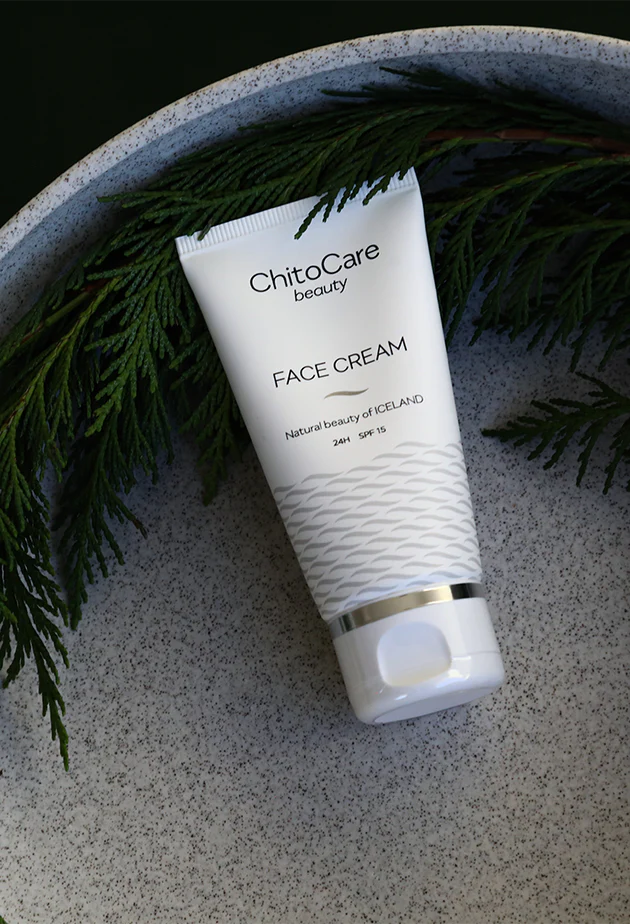
The Layers of the Skin & How to Care for Them
Our skin is the largest organ in the body and is made up of different layers that are interdependent, each one with a different function. As we age, these layers are affected differently, so knowing a bit about them can help you make more informed skincare decisions. A new lesson from the ChitoCare beauty Club is now in session, so take notes.
Human skin is composed of various layers that are made up of specialized, complex and interconnected cells and structures that are ever-changing. Although changes in skin do depend on age, genetics, nutrition and environmental factors, the main cause of skin changes, including premature aging, is exposure to UV radiation. In this post, we’ll take a look at the three main layers of the skin, starting at the bottom and working our way up, and provide tips on how to best care for each one.
HYPODERMIS
Known as the subcutaneous layer, the hypodermis is what helps attach your skin to your bones and muscles. Its main function is to provide the skin with nerves and blood, and it is made up mostly of fat cells, connective tissue, and elastin proteins.
- This layer works as padding, protecting muscles, bones and organs from falls, impacts, bumps and other injuries.
- The high levels of fat within provide a thermal layer of insulation for the body, preventing it from losing heat and serving as an energy reserve when fat supplies run low.
- Elastin proteins in this layer give skin its shape, volume and buoyancy.
The hypodermis runs so deep that skincare products never reach it. This is why nourishment and care for this layer must come from other sources and why skincare ultimately requires a holistic approach that starts on a cellular level.
How the hypodermis changes with age
With age, this fatty layer of the skin loses fat content and becomes thinner. This loss of volume results in wrinkles and reduced plumpness. As the skin becomes less resistant to trauma, it becomes less resilient, so wounds, micro-abrasions or sunburn take longer to heal.
How to care for your hypodermis
Wearing sunscreen with a high SPF is crucial, as mature skin is more sensitive to UV radiation that can result in hyperpigmentation or dark spots. Taking care of your sleep schedule and your diet will also go a long way in keeping your hypodermis healthy, as skin infections can increase with age due to a weakened immune system. Boost your energy levels, antioxidant protection and skin nourishment with ChitoCare beauty Hair, Skin & Nails, a revolutionary bioactive formula, rich in natural nutrients that play a crucial role in maintaining healthy skin, luscious hair and strong nails.
DERMIS
The dermis functions as connective tissue, guarding your body from stress and injury and providing skin with structure, strength, firmness and elasticity. Its main role is to provide blood to the skin, grow hair and create sweat and oil. The papillary region of the dermis is a bumpy surface area that is responsible for your unique fingerprint patterns!
This layer of the skin accounts for roughly 90% of skin thickness and contains much of the body’s water supply. This thick layer is made up of blood vessels, connective tissue and nerve endings, which provide us with the sensation of touch and our ability to sense pressure, heat, pain and other tactile information. This is also where oil glands, sweat glands, sebum glands and hair follicles are located.
The dermis is home to the extracellular matrix. This contains five major components of healthy skin:
- Collagen fibers, that provide structure and strength and act as supporting formations, anchoring cells to each other
- Elastin fibers, that provide tissues with elasticity, resilience and bounce
- Fibroblast cells, that secrete fibrous collagen and elastin proteins, that maintain the structural framework for tissues, and adhesive proteins that help with wound healing
- Proteoglycans, that support the hydration of the extracellular matrix by storing moisture – up to 1000 times their molecular weight in water!
- Hyaluronic acid, that provides both biochemical and structural support for surrounding cells and increases water content in our skin, protecting cells from premature aging, decreasing inflammation and helping with wound healing
How the dermis changes with age
With age, skin loses its ability to maintain sufficient amounts of collagen and elastin. The breakdown of collagen and elastin fibers can result in reduced skin thickness, firmness and elasticity. As oil glands in the epidermis decrease their production of oil and as proteoglycans diminish, skin can become dry, dehydrated, itchy or rough. Furthermore, blood vessels become fragile and can break more easily, resulting in more visible bruising or bleeding.
How to care for your dermis
To support this layer of your skin, make sure you supply it with sufficient moisture and water, in the form of topical applications of serums and creams. This layer is where skin cancers, photoaging and dark spots can develop, so it is also important to wear a high SPF sunscreen, even on cloudy days. Apply deeply hydrating serums that provide firmness and elasticity and feed your proteoglycans with much-needed water. Incorporating antioxidants into your skincare will support your skin's barrier function. Feed your skin with moisture, antioxidant and protective chitosan, and nourishing hyaluronic acid with ChitoCare beauty Anti-Aging Repair Serum, to promote skin hydration, moisture and elasticity.
EPIDERMIS
As your first layer of defence, the epidermis is your protective barrier against the external environment. Even though it is as thin as a sheet of paper, this waterproof outer layer protects you and your immune system from the elements. Its main function is to produce new cells deep within its lower layers. As new, healthy cells form, they push dead cells upwards, that gradually harden and fall away. This cycle happens roughly once every four weeks.
This layer contains no blood vessels, but instead consists of 4-5 sublayers of tightly packed cells, including keratinocytes, that store keratin, a skin-strengthening protein. Alongside fatty acids and water, they create a network of protection, acting as a barrier against:
- pathogens, toxins, bacteria, fungi and viruses
- UVA and UVB radiation
- harsh weather conditions
- transepidermal water loss
The epidermis is also responsible for your skin’s unique colour and tone, pigmentation patterns and melanogenesis – which is how the skin reacts to UV radiation in the form of melanin creation, protecting it from UV rays. The epidermis also includes skin pores, which allow for oil, dirt and sweat to escape your body.
How the epidermis changes with age
As we age, the epidermis layer becomes thinner and cell renewal slows down, resulting in rougher skin texture, a paler complexion and pigmentation due to sun exposure. Free radicals, oxidative stress and toxins accumulate, resulting in wrinkles and fine lines. Melanin distribution loses regularity, resulting in uneven pigmentation.
How to care for your epidermis
To unveil brighter, smoother skin with an even tone and texture, use a gentle exfoliator to boost skin regeneration. Use antioxidant serums and creams to fight the effects of free radical proliferation and to help restore nutrients in your skin. The epidermis is where sunburn and skin cancer occur, so wearing a high SPF sunscreen is crucial to protecting your skin from photoaging and harmful UV radiation. Guard your skin from dryness and promote its natural renewal process with ChitoCare beauty Face Cream, containing powerful antioxidants like coconut and macadamia nut oil, restorative aloe vera leaf juice and tissue regenerative Pseudoalteromonas Ferment Extract.




